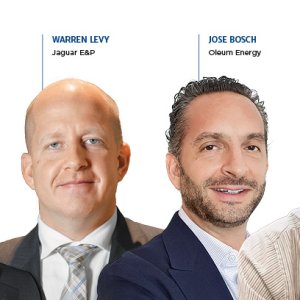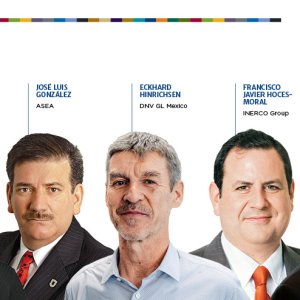
Changing Nature of Aftermarket and Aftersales Services
Left to right: Gerardo Varela, Enrique Enrich, Pedro Albarrán, and Andrés Lerch.
Once the first networking coffee break had concluded, attendees were invited to observe a panel discussion about the changing nature of aftermarket and aftersales services. Moderating the panel was Gerardo Varela, Director General of ZF Services Mexico, Central America and the Caribbean, who opened the discussion with the statistic that 54% of the vehicle park in Mexico is counted as legal market, the other 46% represents imported vehicles from the US but do not meet safety standards in Mexico. The panel agrees that it is in auto makers’ as well as clients’ interests for all the vehicles in Mexico to be the best state possible. Andrés Lerch, Advisory Partner and Leader of the Operations Transformation Area at Ernst & Young’s Mexico Automotive Center, confirmed that “maintenance is not carried out as much as necessary, because of a cultural habit.”
Varela followed up by stating “Twenty years ago, the aftermarket was in the distributors’ hands, but this has changed as a result of an informal aftermarket, as have warranties, which have increased from one-year warranties to three or even five years for certain brands.” Pedro Albarrán, Director General of Hyundai Motor de México then pointed out that Hyundai’s five-year guarantee helps retain clients, as well as announcing a new initiative to replace two tires per year for new clients that will be launched this year. Lerch believes that clients need to be pushed toward the original manufacturers, to increase the 57% of customers that buy cars based on the brand’s post-sales service. However, “only 10% of vehicle owners use dealership workshops for MOTs,” explained Albarrán.
Enrique Enrich, Director General of Scania joined the debate saying that while the vehicle park is not increasing, customer loyalty is subject to change. “The 53 different brands in Mexico are all competing to offer the best possible service to light vehicle customers, so customers should not continue to be the only demographic concerned with vehicle maintenance.”
Following the JIT logistics trend, Hyundai has been able to reduce the need to stock three months of repair parts in workshops that was true in the past, only requesting 20 days’ worth of products via distribution centers. “These centers can cover 97% of requests, increasing the speed at which dealerships can conduct vehicle services,” stated Enrich. Technological advances allow companies to know what parts will need to be changed and have them waiting for a client when they arrive at their nearest dealership, in the exact bay where the car will be received.
In the US, 38% of clients service their vehicles at dealerships, but the 10% that do so in Mexico need to be increased. Lerch explained that repair kits can be ready and waiting for clients, and payment and part registry is automated such that clients leave the dealership with a good impression. “As more clients attend dealerships for vehicle services, they tend to recognize the quality and return for the next service,” expands Lerch. Clients are becoming more informed, and this is reflected in internet vehicle purchases, which is expected to increase in the near future, according to Varela. Lerch estimates that customers take around 12 hours to decide which vehicle to purchase, but that this will increase facilitated by the availability of information on the internet. Varela concluded the panel by predicting an important change in the aftermarket segment as a result of the reduction of the informal market, in the hopes that car dealers will be able to retain their clients for much longer.














